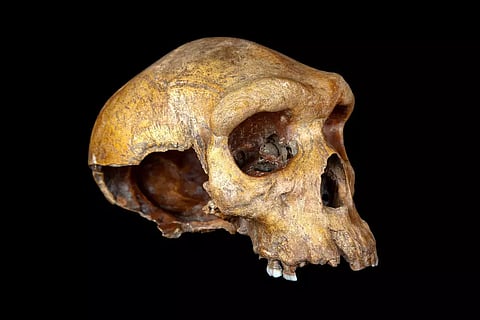

NEW YORK: No place on the planet has escaped the influence of Homo sapiens, from the rainforests cleared for farms to microplastic-laced deep oceans to climate-altered jet streams. Last November, the world population reached 8 billion.
But as omnipresent as humans may be today, a team of scientists now claims that our species came very close to never appearing at all. Researchers in China have found evidence suggesting that 930,000 years ago, the ancestors of modern humans suffered a massive population crash. They point to a drastic change to the climate that occurred around that time as the cause.
Our ancestors remained at low numbers — fewer than 1,280 breeding individuals — during a period known as a bottleneck. It lasted for over 100,000 years before the population rebounded. “About 98.7 percent of human ancestors were lost at the beginning of the bottleneck, thus threatening our ancestors with extinction,” the scientists wrote. Their study was published on Thursday in the journal Science.
If the research holds up, it will have provocative implications. It raises the possibility that a climate-driven bottleneck helped split early humans into two evolutionary lineages — one that eventually gave rise to Neanderthals, the other to modern humans.
But outside experts said they were skeptical of the novel statistical methods that the researchers used for the study. “It is a bit like inferring the size of a stone that falls into the middle of the large lake from only the ripples that arrive at the shore some minutes later,” said Stephan Schiffels, a population geneticist at Max Planck Institute for Evolutionary Anthropology in Leipzig, Germany.
For decades now, scientists have reconstructed the history of our species by analysing the genes of living people. The studies all take advantage of the same basic facts of our biology: every baby is born with dozens of new genetic mutations, and some of those mutations can be handed down over thousands or even millions of years.
By comparing genetic variations in DNA, scientists can trace people’s ancestry to ancient populations that lived in different parts of the world, moved around and interbred. They can even infer the size of those populations at different times in history. These studies have gotten more sophisticated as DNA sequencing technology has grown more powerful. Today, scientists can compare the entire genomes of people from different populations.
Every human genome contains over 3 billion genetic letters of DNA, each of which has been passed down for thousands or millions of years — creating a vast record of our history. To read that history, researchers now use increasingly powerful computers that can carry out the vast numbers of calculations required for more realistic models of human evolution. Haipeng Li, an evolutionary genomics researcher at Chinese Academy of Sciences in Shanghai, and his colleagues spent over a decade creating their own method for reconstructing evolution.
The researchers named the method FitCoal (short for Fast Infinitesimal Time Coalescent). FitCoal lets scientists cut up history into fine slices of time, allowing them to create a model of a million years of evolution divided into periods of months.